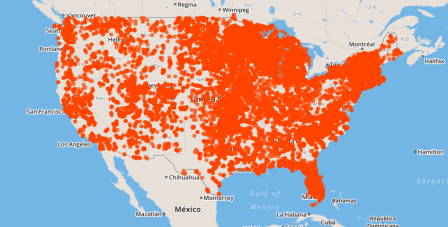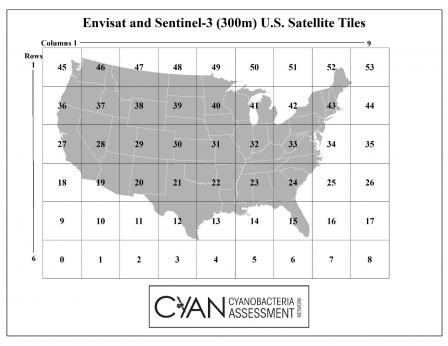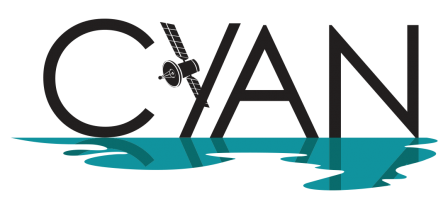Cyanobacteria Assessment Network (CyAN)
On this Page
An EPA, NASA, NOAA, and USGS Project
CyAN is a multi-agency project among EPA, the National Aeronautics and Space Administration (NASA), the National Oceanic and Atmospheric Administration (NOAA), and the United States Geological Survey (USGS) to develop an early warning indicator system to detect algal blooms in U.S. freshwater systems. This research supports federal, state, tribal, and local partners in their monitoring efforts to assess water quality to protect aquatic and human health.
Project Overview
The mission of the CyAN's project is to support the environmental management and public use of U.S. lakes and estuaries by providing a capability of detecting and quantifying algal blooms and related water quality using satellite data records.
Goals
- Develop a uniform and systematic approach for identifying cyanobacteria blooms across the contiguous U.S. using ocean satellites.
- Create a strategy for evaluation and refinement of algorithms across satellite platforms.
- Identify landscape linkage postulated causes of chlorophyll a and cyanobacterial blooms in freshwater systems.
- Characterize exposure and human health effects using ocean color satellites in drinking water sources and recreational waters.
- Characterize responses and economic value of an early warning system using ocean satellites and a mobile dissemination platform.
- Disseminate satellite data through a mobile application and EnviroAtlas.
Planned Outcomes
- Create a standard and uniform approach for early identification of algal blooms that is useful and accessible to stakeholders of freshwater systems using the new set of satellites: Ocean Land Colour Instrument (OLCI) on Sentinel-3, Sentinel-2, Landsat and future NASA missions.
- Develop an information dissemination system for expedient public health advisory postings.
- Better understand connections between health, economic, and environmental conditions to cyanobacteria and phytoplankton blooms.
Project Timeline
The CyAN project officially started October 1, 2015. It provided continental U.S. coverage using the MERIS archive from 2002-2012 in Fiscal Year 2017. Weekly composites of the European Space Agency Copernicus Sentinel-3 OLCI sensor data are now available to collaborators for initial review and validation. Landsat surface water temperature product is now publicly available through USGS EROS.
Project Components and Fiscal Year Updates
[Validation] [Satellite Algorithms] [Cross-Satellite Platforms] [Environmental Assessment] [Human Health] [Economics] [Decision Support]
Validation
In situ validation data will primarily come from our federal and state collaborators. Sources of data will include, but are not limited to, federal, state, and local government agencies, universities, private research groups, and published peer-reviewed journals. Minimum data reporting requirements include sample station identification, cyanobacteria counts, abundance, or phycocyanin pigment concentration, latitude, longitude, depth, and date. Additional information that are not required but are considered beneficial include chlorophyll a concentration (especially), temperature, secchi depth, turbidity, and other available water quality measures. Data sets will undergo quality review by confirming that all methods used were documented and widely accepted.
 Figure 1. CONUS streetmap with site data from CyAN Field Integrated Exploratory Lakes Database. Fiscal Year 2019 Update: A field sampling effort was undertaken in Kansas, Minnesota, North Carolina, and Wisconsin to increase the number of in situ match-ups for validating the Cyanobacteria Index algorithm. The in situ sampling suite included radiometry, phytoplankton species composition, chlorophyll, cyanotoxins, and secchi depth and resulted in at least two dozen match-ups across Sentinel-3A and –3B. The CyAN Field Integrated Exploratory Database (FIELD) is going through internal review for public release and data for the Great Lakes is now being collated. The code for the CyAN FIELD tool has been provisionally released and the Land Change Monitoring, Assessment, and Projection (LCMAP) product is currently being evaluated for consistency in a watershed in Kansas for annual landcover/land change using Landsat.
Figure 1. CONUS streetmap with site data from CyAN Field Integrated Exploratory Lakes Database. Fiscal Year 2019 Update: A field sampling effort was undertaken in Kansas, Minnesota, North Carolina, and Wisconsin to increase the number of in situ match-ups for validating the Cyanobacteria Index algorithm. The in situ sampling suite included radiometry, phytoplankton species composition, chlorophyll, cyanotoxins, and secchi depth and resulted in at least two dozen match-ups across Sentinel-3A and –3B. The CyAN Field Integrated Exploratory Database (FIELD) is going through internal review for public release and data for the Great Lakes is now being collated. The code for the CyAN FIELD tool has been provisionally released and the Land Change Monitoring, Assessment, and Projection (LCMAP) product is currently being evaluated for consistency in a watershed in Kansas for annual landcover/land change using Landsat.
- Fiscal Year 2018 Update: CyAN has developed appropriate statistical metrics for satellite algorithm comparison and validation. The metrics for algorithm comparison are critical as an evaluation tool for managers interested to know which algorithms may preform best in their areas of interest. The open access CyAN Field Integrated Exploratory Lakes Database (CyAN FIELD) tool continues development using R-script, R-Studio, Shiny app interface to visualize and QA field and laboratory measurements for parameters relevant to validation of remote sensing products. The database has automated QA queries to avoid having to manually check each record and to check for inter-parameter agreement.
- Fiscal Year 2017 Update: As seen in Figure 1, the CyAN Field Integrated Exploratory Lakes Database (CyAN FIELD) functionality has been expanded to include integrated tools for interactive quality control and basic exploratory analysis to evaluate data trends. Automated quality control queries have been added to evaluate internal consistency of sample location information, and that interrelated chemical, biological, and physical data are internally consistent.
Satellite Algorithms
A strategy for evaluation of algorithm updates has been established in large part through the open source availability of the NASA ocean color processing software (l2gen) and the SeaWiFS Data Analysis System (SeaDAS). This project will perform a complementary effort by using existing products for MERIS (Medium Resolution Imaging Spectrometer) and OLCI that have shown management value to establish algorithm development and data processing infrastructure. We propose to adopt second derivative spectral shape algorithms, which have been shown to be robust in the presence of poor atmospheric correction. For MERIS data, the bands at 620, 665, 681, 709, and 754 nanometers are used. The Cyanobacteria Index algorithm estimates cyanobacteria concentrations and the algorithm has been successfully transferred to MODIS (Moderate Resolution Imaging Spectroradiometer).
- Fiscal Year 2019 Update: Algorithm updates included improved quality flags for invalid pixels and atmospheric stray light (sometimes called land adjacency) and a revised land mask. The color table for the standard image products was adapted to a perceptually uniform color based on a modified form of the viridis system, which is one of the default tables in python’s matplotlib. This form also addresses color deficiency, which is poorly handled with the “rainbow” method. CyAN now includes the addition of Alaska to the standard processing stream, generation daily images, and true color daily imagery for both the continental U.S. and Alaska at the request of the states. National chlorophyll validation with in situ data from the Water Quality Portal was underway.
- Fiscal Year 2018 Update: The Sentinel-2 satellite constellation shows some potential for deriving chlorophyll a across lakes in the United States. Work is ongoing to better understand which conditions are appropriate for use of algorithms at higher resolution scales. Flags for non-bloom, non-water conditions are still factors limiting the MERIS and OLCI data sets. Several factors have been examined, including thin ice and atmospheric adjacency in extremely turbid atmospheres. Modifications to the flags are being developed to exclude these characteristics.
- Fiscal Year 2017 Update: Standardized algorithm intercomparison metrics have been developed and were presented and incorporated into recommendations at the biannual International Ocean Colour Science team meeting. Toxin distributions are a concern to managers, however remote sensing cannot detect toxins. A strategy for estimating toxin levels with satellite data has been identified. In addition, the relative sensitivity of phycocyanin against chlorophyll for cyanobacteria detection was determined: two to four times as much phycocyanin is needed to detect the same amount of cyanobacteria biomass as can be detected with chlorophyll.
Cross-Satellite Platforms
The reliable application of any remote-sensing algorithm over a large area requires a strategy for its evaluation, validation, and refinement on multiple spatial and temporal scales using field reference data. As our knowledge of the statistical and analytical relationships within the algorithm improve with time, successes and failures need to be understood, as does the ongoing need for refinement of algorithm parameterizations. Using in situ data as reference and data from multiple ocean color satellite instruments, we will compare (1) model output from in situ radiometry vs. in situ metrics for cyanobacteria, (2) satellite radiometry vs. in situ radiometry and model output from satellite radiometry vs. in situ metrics for cyanobacteria, and (3) model outputs from multiple satellite instruments (MERIS and Landsat).
 Figure 2. Example of how CyAN divides the satellite images into smaller files. The numbered tiles each represent a spatial area that will be made into a separate file. The data file name will use the row and column number to identify the tile location. Satellite data is from the European Space Agency Envisat MERIS and Copernicus Sentinel-3 Ocean and Land Colour Imager (OLCI) sensors Fiscal Year 2019 Update: Validation of the Sentinel-2 Maximum Chlorophyll Index (MCI) is complete. Comparison of Sentinel-2 chlorophyll measurements to in situ chlorophyll a measurements indicates that some error is present but that the two generally agree on whether concentrations are high or low.
Figure 2. Example of how CyAN divides the satellite images into smaller files. The numbered tiles each represent a spatial area that will be made into a separate file. The data file name will use the row and column number to identify the tile location. Satellite data is from the European Space Agency Envisat MERIS and Copernicus Sentinel-3 Ocean and Land Colour Imager (OLCI) sensors Fiscal Year 2019 Update: Validation of the Sentinel-2 Maximum Chlorophyll Index (MCI) is complete. Comparison of Sentinel-2 chlorophyll measurements to in situ chlorophyll a measurements indicates that some error is present but that the two generally agree on whether concentrations are high or low.- Fiscal Year 2018 Update: CyAN has generated mission-long daily and weekly composites of MERIS and OLCI cyanobacteria and chlorophyll a data products for the continental U.S. A reprocessing of these time-series is anticipated in winter 2018. The reprocessing will encompass updates to the algorithm, the approach for identifying mixed land-water pixels, and the land mask. Improvements have been made to the geotiff data files so metadata is now contained in the geotiff files, and the format is compatible with ArcGIS.
- Fiscal Year 2017 Update: As seen in Figure 2, CyAN generated MERIS CI composites for the full mission at 300 m for the full continental United States (CONUS). Temporal scales for these composites are 14-days for 2002-2007, when MERIS CONUS coverage was incomplete, and 7-days for 2008-2012. These MERIS CI data are available for project collaborators evaluation. As of August 30, 2017, CyAN is processing Sentinel-3 OLCI in forward stream.
Environmental Assessment
The Environmental Component of the CyAN project focuses on the evaluation of the existing satellite data to document changes in land-cover composition, land-use activities, chlorophyll a, and cyanobacteria concentrations.
- Fiscal Year 2019 Update: Quality assurance flags were completed for the presence of snow/ice, land-adjacency, and unresolvable waterbodies supporting water quality derived measures from Envisat MEdium Resolution Imaging Spectrometer and Sentinel-3 Ocean and Land Colour Instrument for the continental United States. In addition, an updated waterbody mask that contains valid waterbody and coastal ocean delineation is complete. The flag dataset will be used in the development of national-scale metrics for derived water quality. A method to quantify the ooccurrence of cyanobacterial blooms across lakes has been developed.
- Fiscal Year 2018 Update: Methods to quantify the frequency, extent and magnitude of cyanobacteria in satellite resolvable lakes across the U.S. have been developed. Random forest models have been used to generate landscape variable importance metrics and a Classification and Regression Tree (CART) algorithm to visualize the important associations between the top drivers and cyanobacteria. The study investigated numerous physiographic and anthropogenic factors of lakes and their watersheds; >300 lakes across the Midwest and Northeast were included.
- Fiscal Year 2017 Update: An approach for identifying lakes that can be resolved by any satellite given different pixel resolutions has been defined, and a method to quantify the frequency of bloom occurrence in recreational and surface drinking water sites has been developed. A method for examining temporal changes in cyanobacteria harmful algal bloom spatial extent for state level assessment, transferable to different spatial areas was also developed.
- Approach for identifying resolvable lakes
- Method to quantify bloom frequency
- Method for examining temporal changes
Human Health
Remote sensing of cyanobacteria blooms offers a unique opportunity to estimate human exposure to cyanotoxins over specific geographic areas.The health of those communities with a past history of cyanobacteria blooms detected via satellite may be evaluated retrospectively by the analysis of existing health records.
- Fiscal Tear 2019 Update: Epidemiological studies on the association between cyanobacterial blooms in drinking water sources and human health outcomes are scarce. CyAN evaluated if satellite derived cyanobacterial blooms were associated with increased medical visits for a limited case study.
- Fiscal Year 2018 Update: The CyAN team has analyzed health data from a prospective epidemiology study at a Great Lakes Beach, along with retrospective satellite imagery of the near shore water during the study period. We estimated participant exposure during the study period and evaluated health effects after exposure to water during remotely sensed blooms.
- Fiscal Year 2017 Update: Analysis of a study of human health effects associated with exposure to recreational water at a Great Lakes beach is underway. Although this prospective epidemiology study was conducted in 2003, for this project, we retrospectively evaluated beachgoer’s potential exposure to phytoplankton using two different remote sensing methods: the MODIS ocean chlorophyll a (OC4) algorithm and the MERIS cyanobacteria index (CI).
Economics
Across the U.S., many states are developing programs to monitor bloom events. However, monitoring can be expensive, takes time, and results are often not available in enough time for management decisions. Automated detection of events based on remote sensing has the potential to improve the quality and timing of HAB-related data delivery to those who need it. The costs associated with monitoring algal blooms, and the economic value of early bloom event detection using remote sensing data are being identified.
- Fiscal Year 2019 Update: Economic analysis for the health advisory and monitoring studies are complete. The annual potential avoided costs associated with increasing the availability of remotely sensed chlorophyll a values were estimated depending upon the satellite program used. This analysis underscored the importance of continued support for both field-based in situ monitoring and satellite sensor programs that provide complementary information to water quality managers, given increased challenges associated with eutrophication, nuisance, and HAB events.
- Fiscal Year 2018 Update: CyAN is working with the Valuables Consortium to estimate the value of the socioeconomic benefits of having satellite imagery available for detecting algal blooms. CyAN is also comparing the spatial and temporal extent of chlorophyll a measurements available from two satellite platforms (Sentinel-3 & Landsat) and in situ water quality monitoring datasets. As part of this analysis, the value added of in situ sampling is compared to the expenditures required to store, manage, and make satellite-derived data available.
- Fiscal Year 2017 Update: CyAN quantified the benefits of using remote sensing and field-based monitoring data to detect chlorophyll a as a general indicator of harmful algal blooms. This effort investigates the spatial and temporal coverage of both satellite and field based observations across US lakes and potential costs and trade-offs. This work examines the extent of chlorophyll a observations across the CONUS for both the Landsat (OLI) and Sentinel 3 (OLCI) satellites and makes comparisons with the spatial and temporal extent of existing national programs collecting in situ field observations of chlorophyll a.
Decision Support
Satellite data that is accessible to scientists is not typically processed and delivered to the public in a manner that demonstrates its practical value to daily life. The CyAN Android™ mobile application is the first platform for immediate decision support. The second platform is the EnviroAtlas for longer-term trend analysis. Additional software packages for data analysis include RS Tools for GIS and the open source SeaDAS software.
- Fiscal Year 2019 Update: The CyAN Android mobile app was publicly released in July 2019. Webinar trainings were provided to EPA and state partners on ArcGIS RS Tools, SeaDAS, mobile application, and version 2 of the CyAN data. The CyAN project currently supports 33 states with the addition of Alaska.
- Fiscal Year 2018 Update: The mobile app continued beta testing with collaborators, such as validating against 25 state health advisories issued in 2017 across seven states. CyAN continues to work with several states, localities, and various organizations such as California Water Board, Army Corps of Engineers, and non-profits. We have also evaluated a new color bar for use with imagery in response to requests from numerous collaborators. The standard rainbow has been recognized as having several deficiencies. A new colormap, based on the python default “viridis” colormap, is perceptually uniform, and more suitable for those with red-green color blindness. Trainings on SeaDAS, ArcGIS RS Tools, and the app were held in April-May 2018 and planned again for 2019. A successful outreach effort called Sippin’on Science had ten public events throughout the upper Midwest lakes region combined hands-on science with a presentation about the project’s local relevance.
- Fiscal Year 2017 Update: The CyAN Science team held multiple training sessions in FY17. The first session was an introduction to SeaDAS for state and federal stakeholders, the second was an introduction to the RSTools toolkit for ArcGIS and basics of the products being produced through the project. A smaller-scale training was held for collaborators asked to beta test the CyAN mobile application. RSTools, the package for ArcGIS, was modified to support both NASA and NOAA naming conventions for MERIS and OLCI. It supports Sentinel-3A, as well as Envisat (MERIS) and MODIS. RSTools allows calculation of all composites and extraction of time series data for point and shape polygons by any agency using ArcGIS. The CyAN mobile app is operational and providing weekly OLCI data for the CONUS to collaborators. It is currently available to any state regulatory agency or health department for beta testing (see "Project Contacts" below).
Disclaimer: Any mention of trade names, manufacturers, or products does not imply an endorsement by EPA. EPA and its employees do not endorse any commercial products, services, or enterprises.
Contacts and Resources
Contacts and Technical Assistance
- For comments or questions, contact us about the CyAN Project.
- Leads for each Agency: Blake Schaeffer (EPA), Jeremy Werdell (NASA), Keith Loftin (USGS), and Richard Stumpf (NOAA)
Resources
Journal Articles
- Quantifying national and regional cyanobacterial occurrence in US lakes using satellite remote sensing (2020)
- Satellite resolvable estuaries within the continental United States (2020)
- Envisat MERIS and Sentinel-3 OLCI Satellite lake water quality flags for the contiguous United States (2020)
- Satellite detected cyanobacteria in large U.S. lakes on your Android phone (2019)
- Ocean Colour: current status and future perspectiveExit(2019)
- Measurement of cyanobacterial bloom magnitude using satellite remote sensing (2019)
- Towards a satellite-based monitoring system for water quality (2018)
- Extending century-long monitoring of global water clarity to the future (2018)
- Mobile device application for monitoring cyanobacteria HABs using Sentinel-3 satellite Ocean and Land Colour Instruments (2018)
- Evaluation of RapidEye data for mapping algal blooms in inland watersExit(2018)
- An initial validation of Landsat 5 and 7 derived surface water temperature for U.S. lakes, reservoirs, and estuaries (2018)
- Performance metrics for the assessment of satellite data products: an ocean color case study (2018)
- Monitoring algal blooms in drinking water reservoirs using the Landsat-8 Operational Land Imager (2018)
- Satellite monitoring of cyanobacterial HAB frequency in recreational waters and drinking source waters with satellites (2017)
- A method for examining temporal changes in cyanobacteria HAB spatial extent using satellite remote sensing (2017)
- Challenges for mapping cyanotoxin patterns from remote sensing of cyanobacteria (2016)
- Forecasting annual cyanobacterial bloom biomass to inform management decisions in Lake ErieExit(2016)
- Evaluation of time-series smoothing algorithms for land-cover classifications using MODIS-NDVI multi-temporal data (2016)
- Evaluation of cyanobacteria cell count detection derived from MERIS imagery across the eastern USA (2015)
- A satellite perspective to monitor water quality using your mobile phoneExit(2015)
- Agencies collaborate, develop a Cyanobacteria Assessment Network (CyAN) (2015)
Related Resources


